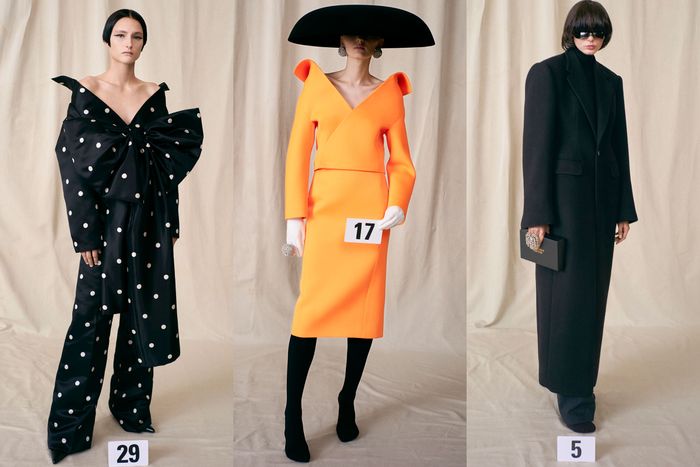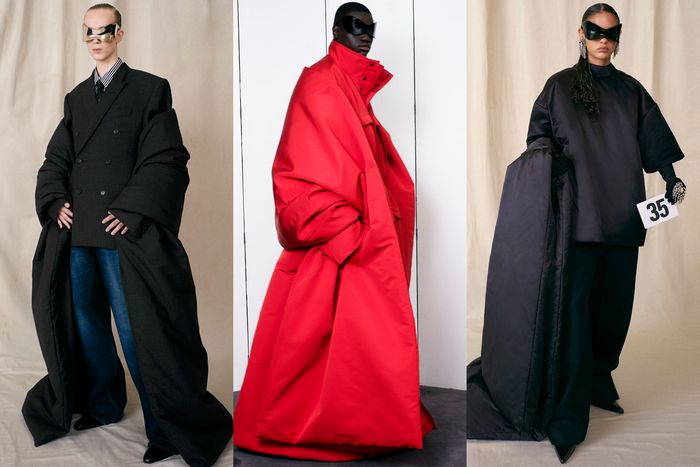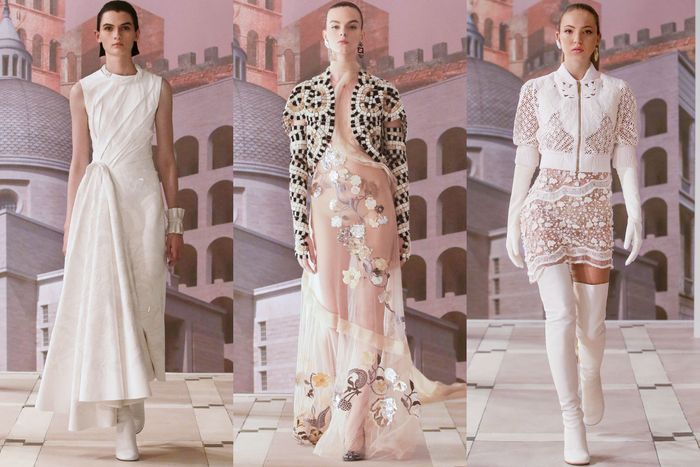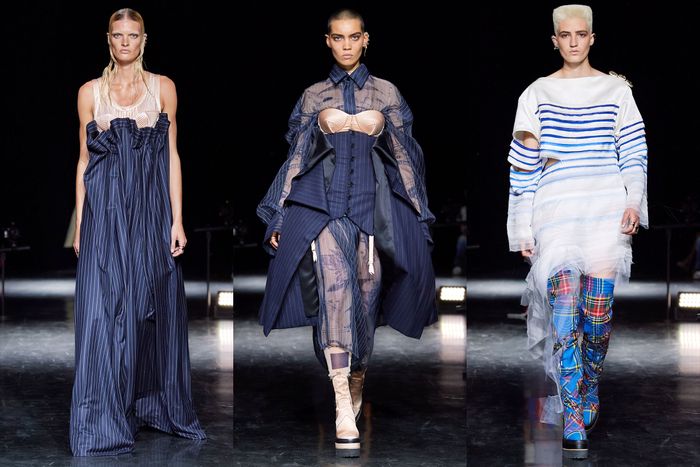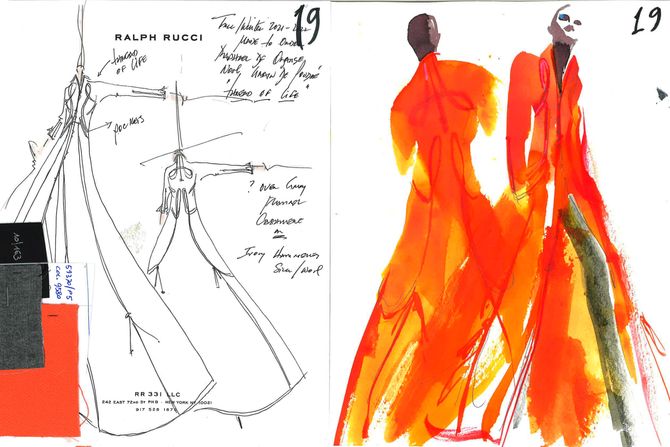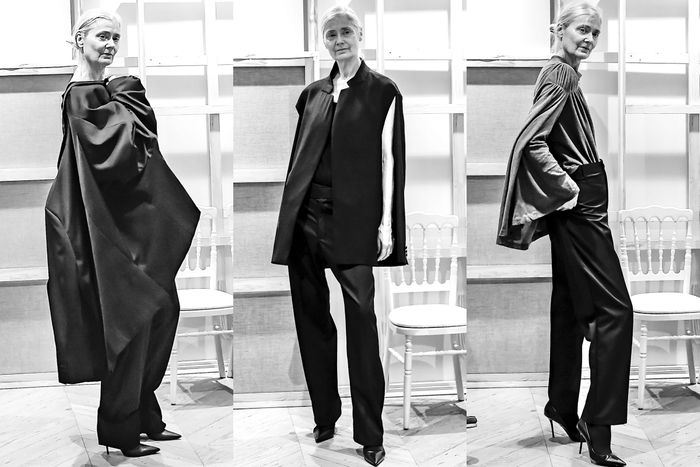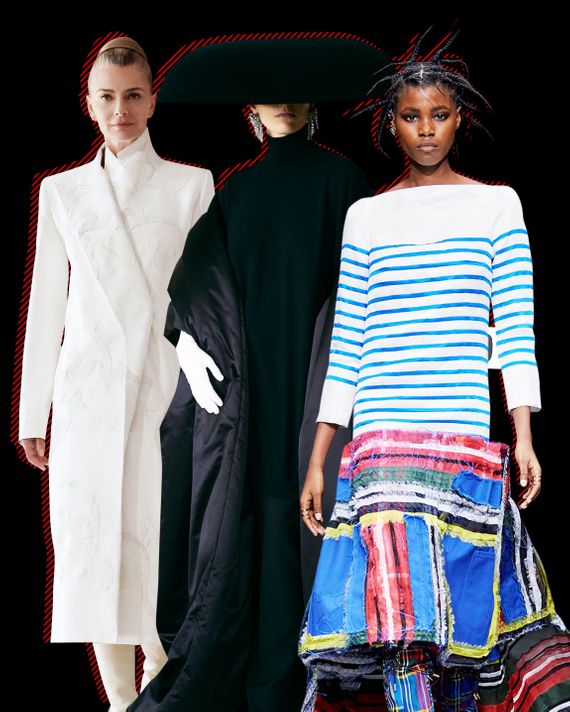
Over much of his six years as creative director of Balenciaga,Demna Gvasliahas been on a mission to bring fashion into the future. He’s designed molded suitsusing 3-D printingtechnology, he’s conceivedscenes of climate-spawned disaster,andhis modelswouldn’t look out of place in a Ridley Scott film featuring robots. In short, his vision is light-years from the ineffable chic of an opera coat in lilac satin designed by the house’s founder, Cristobal Balenciaga.
But this week, Gvasalia, who has had an influence on a sizable portion of the fashion world — for his oversize tailoring and beefed-up hoodies and parkas — indicated he was reversing his jets. The occasion was the debut in Paris of his haute couture collection, the first in the Avenue George V house since Cristobal closed it in 1968 and went home to Spain, where he died four years later, having largely avoided the press.
Facing a throng of journalists, Gvasalia said, “I learned that we cannot look into the future, we need to look into the past to know where we are going.”
This is unquestionably true, but until that moment on Wednesday we’ve seen relatively few examples of a contemporary designer successfully marrying his vision with that of a founder’s — and not just marrying but also expanding our understanding of a brand’s legacy. For me, this was the most remarkable aspect of Gvasalia’s debut, by any measure a triumph. The genius of Balenciaga is hardly hidden — we know about it from books and exhibits, from Penn’s photographs. But compared to the visual knowledge around Chanel, which was helped massively byKarl Lagerfeld,we know very little about Balenciaga and why he still matters. To be sure,Nicolas Ghesquière,in his years as creative director, opened the door, but it was only a crack compared to what Gvasalia, 40, has done.
Let’s consider the accomplishment. Through the small, somewhat degenerate institution of haute couture — the side of the French fashion business that produces handmade, made-to-measure clothes for a few thousand private customers — Gvasalia has exposed, more profoundly than any of his predecessors, the power and allure of the house. He has done so partly by restoring the legendary George V headquarters, using old photographs and the Berlin design firm Sub to remake the original couture salon moldings and furniture. And he has done so partly with his clothes, a distillation of key Balenciaga forms and silhouettes — the semi-fitted suit of the ’50s, for example, the majestic opera coats — that ultimately stress, rightly, the modern eye of Gvasalia.
“He is the most modern designer there is right now,” another top designer told me on Wednesday.
I don’t think there was much doubt about that by the fifth look in the show, a series of rigorously tailored tuxedos and a black cashmere coat in Gvasalia’s over-scaled style. Everything was flawlessly executed, and materials like a compact gabardine (for suiting), vicuna (for ridiculously soft turtlenecks) and silk-wool blends, all with a matte finish, added to the sense of rigor. Outfits would have gone through a half a dozen or more fittings each. It clearly helped that because of delays caused by the pandemic Gvasalia and his staff had more time than is standard to work on the collection. “I was lucky to have a year,” he said. In fact, going forward, Balenciaga will show only one couture collection a year, in July.
It is difficult to work with iconic forms without parking oneself in them, and heaven knows many designers have made successful careers doing just that — tweaking the “codes” of a heritage brand but never really proposing anything new. Not Gvasalia. The vibrant orange loose-back suit in the collection, its jacket seemingly based on Cristobal’s famous fisherman’s blouse, is a stunning example of how he has advanced not just the form, but fashion. And like many of the pieces, notably a modified black opera coat in a kind of dense silk, and afauxsilver fox jacket that is embroidered bits of fabric, the suit has a hard-to-define, everyday quality about it.
That opera coat? Shown with jeans made from the finest Japanese denim, it almost feels in the hand like the best sports nylon. The drama, the preposterous glamour of the fat collar — that’s fashion. The balance of the materials and the attitude, so carefully worked out in Gvasalia’s head and by expert hands, is what makes it new.
Now what the hell is he going to do for Balenciaga’s ready-to-wear?
Kim Jones, in his second couture season at Fendi, mercifully lost some of the diva grandeur of his first outing. I’m glad I could see the clothes up close, because the video (shot in Romewith Kate Mossand others) doesn’t show how light and youthful the work in fact is. The standout pieces are the marble-white intarsia leather and Python coats and sheaths, a white mini dress done in a cage of shaved mink bits — off cuts from other designs — and tiny feathers, and a gorgeous pale taupe chiffon gown with a delicate garland of embroidered flowers spiraling up the front and a bolero of tiny shaved mink “tiles” evoking a Roman floor. Couture customers were already circling the clothes.
Back in 1997,Jean Paul Gaultiercaused a major stir when he jumped into haute couture, after a career in ready-to-wear. The Brits Alexander McQueen and John Galliano were also invading Paris, but somehow it was Gaultier, the enfant terrible, Madonna’s designer, who truly disrupted, perhaps because he understood French elegance and its myths so well that he could unpack them with ease. He had nudity, men in drag, and spangled versions of the Eiffel Tower on his runway. He also had the most sublime tailoring — modern, cut to the bone. There were seasons — I remember the shows at Marie-Laure de Noailles’s house on the Place des États-Unis in the early 2000s — when his gray trouser suits and trenches were the epitome of savoir-faire.
So I was curious to see how Sacai’s Chitose Abe would dig into Gaultier’s legacy for her one-off collection — he hasretired from the runway— and I was ultimately disappointed. The missing ingredient was savoir-faire. Abe can nimbly deconstruct and fuse, as Sacai fans know, and she did that with some of Gaultier’s greatest hits — slicing up his striped sailor tops, hacking into his pinstripes for a frilled column, turning his denim into a full skirt with jean legs arranged as fanning pleats. But the results looked maddeningly like ready-to-wear — that is, without couture’s impeccable finishing. Conceptually, the collection also felt stale, probably because Abe was reworking ideas that have long been on the shelf.
The AmericanRalph Rucciwas in Paris for his ninth couture tour, meeting editors and clients in a suite at the Ritz. The collection was a concision of stitching techniques on simple and airy shapes, with a modern anchoring of pants. A sketch of a long, lean, sleeveless tunic suggested a vibrant orange-red color-field of sequins; in fact, it was mostly French knots. Lovely. Like other designers this week, Rucci was inspired by artists, namely Helen Frankenthaler and Joseph Beuys — the latter for a painting by Rucci of Beuys in motion on a luxe, spiraling, one-seam silk caftan. “So Joseph runs up and Joseph runs down,” as he put it. A message in script was picked out in copper beads.
“I am a Sunday couturier,” the fashion historian and curator Olivier Saillard said at a showing of his latest side project,Moda Povera.“The idea is not to become Christian Dior,” he added with a laugh. No chance of that, given that his label means poor and the clothes are reworked from existing stock — this season, men’s 8XL suiting. That’s big!
Like many designers — like Julie de Libran, formerly of Vuitton and Sonia Rykiel, who fashions gorgeous, simple, feminine designs from dead stock and also creates new handmade pieces using the best Parisian ateliers — Saillard is interested in things that are sustainable and real. Moda Povera, though, happens to be ingenious. In his mouse-hole studio, Saillard, who is also creative director of J.M. Weston, and his team showed many iterations of the same black suit — pleated, gathered, stream-lined — on one model. He also proposed T-shirt-style tops reshaped with Madame Grès’s Grecian type of draping.
The upshot is you get something made to order, responsible, and just a little bit cool. Saillard has about 50 pieces of clothing on hand to refashion on clients. As much as anything, he views Moda Povera as a kind of challenge.
“I would love to do haute couture low-cost,” he says.



